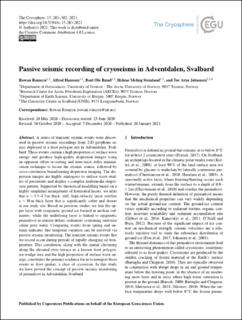| dc.contributor.author | Romeyn, Rowan | |
| dc.contributor.author | Hanssen, Alfred | |
| dc.contributor.author | Ruud, Bent Ole | |
| dc.contributor.author | Stemland, Helene Meling | |
| dc.contributor.author | Johansen, Tor Arne | |
| dc.date.accessioned | 2021-02-19T12:33:21Z | |
| dc.date.available | 2021-02-19T12:33:21Z | |
| dc.date.created | 2021-01-25T10:08:46Z | |
| dc.date.issued | 2021 | |
| dc.identifier.issn | 1994-0416 | |
| dc.identifier.uri | https://hdl.handle.net/11250/2729243 | |
| dc.description.abstract | A series of transient seismic events were discovered in passive seismic recordings from 2-D geophone arrays deployed at a frost polygon site in Adventdalen, Svalbard. These events contain a high proportion of surface wave energy and produce high-quality dispersion images using an apparent offset re-sorting and inter-trace delay minimisation technique to locate the seismic source, followed by cross-correlation beamforming dispersion imaging. The dispersion images are highly analogous to surface wave studies of pavements and display a complex multimodal dispersion pattern. Supported by theoretical modelling based on a highly simplified arrangement of horizontal layers, we infer that a ∼3.5–4.5 m thick, stiff, high-velocity layer overlies a ∼30 m thick layer that is significantly softer and slower at our study site. Based on previous studies we link the upper layer with syngenetic ground ice formed in aeolian sediments, while the underlying layer is linked to epigenetic permafrost in marine-deltaic sediments containing unfrozen saline pore water. Comparing events from spring and autumn indicates that temporal variation can be resolved via passive seismic monitoring. The transient seismic events that we record occur during periods of rapidly changing air temperature. This correlation, along with the spatial clustering along the elevated river terrace in a known frost polygon, ice-wedge area and the high proportion of surface wave energy, constitutes the primary evidence for us to interpret these events as frost quakes, a class of cryoseism. In this study we have proved the concept of passive seismic monitoring of permafrost in Adventdalen, Svalbard. | en_US |
| dc.language.iso | eng | en_US |
| dc.publisher | Copernicus Publications | en_US |
| dc.rights | Navngivelse 4.0 Internasjonal | * |
| dc.rights.uri | http://creativecommons.org/licenses/by/4.0/deed.no | * |
| dc.title | Passive seismic recording of cryoseisms in Adventdalen, Svalbard | en_US |
| dc.type | Journal article | en_US |
| dc.type | Peer reviewed | en_US |
| dc.description.version | publishedVersion | en_US |
| dc.rights.holder | Copyright Author(s) 2021. | en_US |
| cristin.ispublished | true | |
| cristin.fulltext | original | |
| cristin.qualitycode | 2 | |
| dc.identifier.doi | 10.5194/tc-15-283-2021 | |
| dc.identifier.cristin | 1878158 | |
| dc.source.journal | The Cryosphere | en_US |
| dc.source.pagenumber | 283–302 | en_US |
| dc.identifier.citation | The Cryosphere. 2021, 15 (1), 283–302. | en_US |
| dc.source.volume | 15 | en_US |
| dc.source.issue | 1 | en_US |

